Auditing and Assurance: Inventory and Key Audit Matters Report
VerifiedAdded on 2023/04/22
|15
|3987
|99
Report
AI Summary
This report provides an analysis of auditing and assurance principles, focusing on risk assessment and key audit matters (KAM) within the context of Advanced Computer Solutions Ltd. and Green Machine Ltd. It explores the key assertions at risk, including completeness and accuracy for inventory valuation, and valuation and accuracy for property, plant, and equipment (PPE). The report details substantive audit procedures to mitigate identified risks, such as reconciling inventory counts and reviewing depreciation rates. Furthermore, it examines KAM under ASA 701, outlining their objectives, definition, and the requirements for their determination and disclosure. The analysis includes specific situations for both companies, highlighting the selection of KAM and their implications on the audit report. The report concludes with a discussion of the overall auditing process and the importance of addressing material misstatements in financial reporting, providing a comprehensive overview of the audit process.
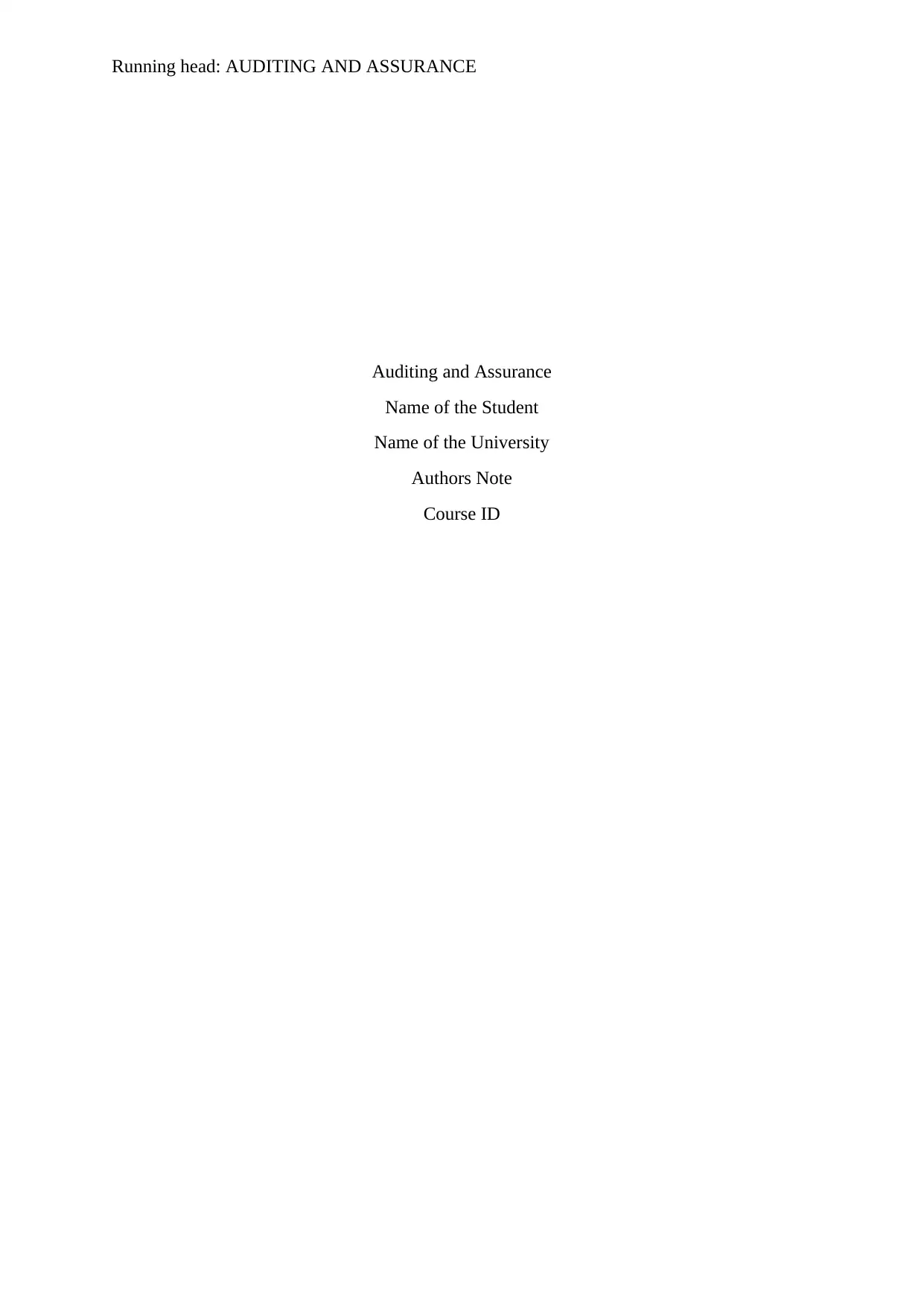
Running head: AUDITING AND ASSURANCE
Auditing and Assurance
Name of the Student
Name of the University
Authors Note
Course ID
Auditing and Assurance
Name of the Student
Name of the University
Authors Note
Course ID
Paraphrase This Document
Need a fresh take? Get an instant paraphrase of this document with our AI Paraphraser
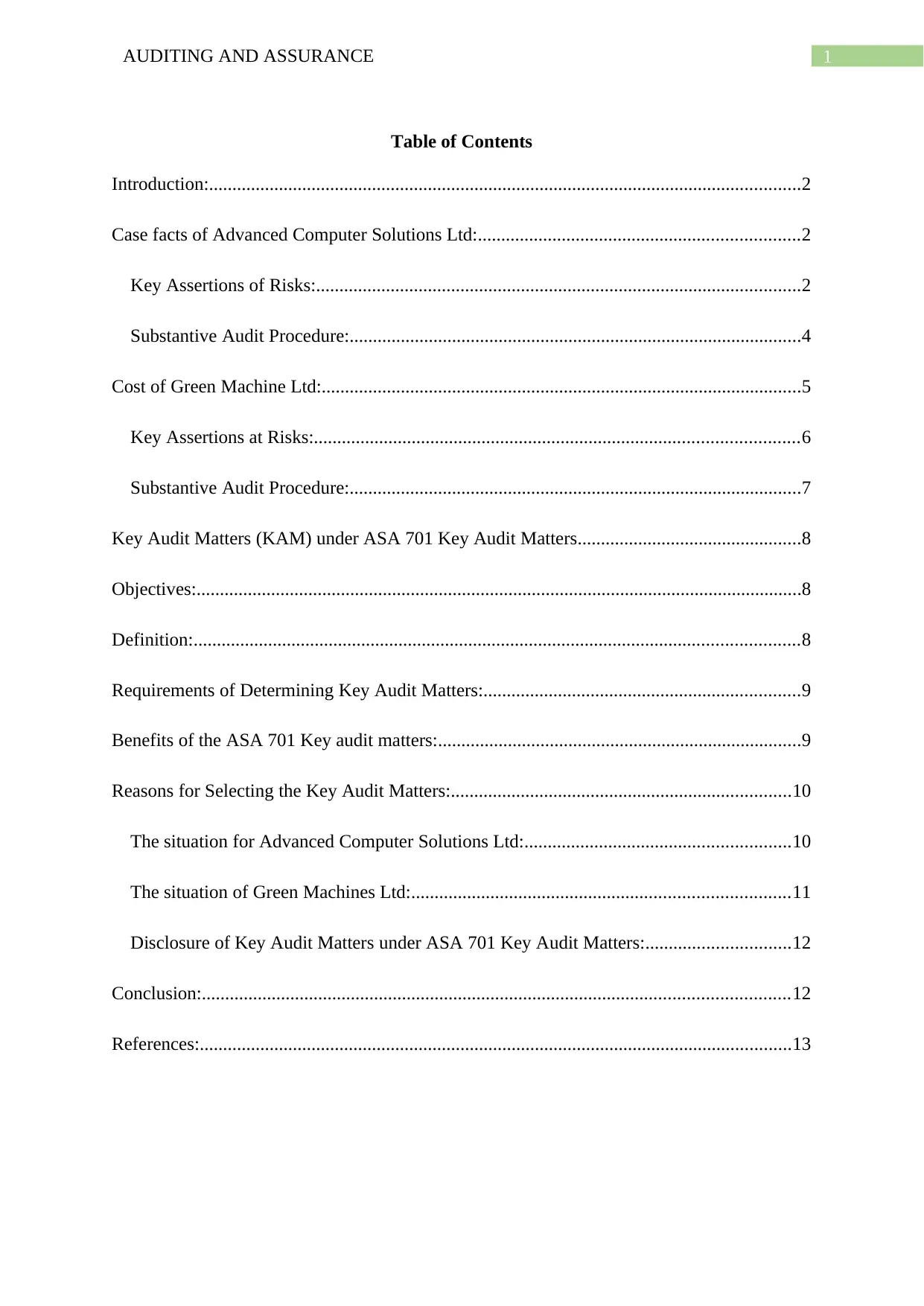
1AUDITING AND ASSURANCE
Table of Contents
Introduction:...............................................................................................................................2
Case facts of Advanced Computer Solutions Ltd:.....................................................................2
Key Assertions of Risks:........................................................................................................2
Substantive Audit Procedure:.................................................................................................4
Cost of Green Machine Ltd:.......................................................................................................5
Key Assertions at Risks:........................................................................................................6
Substantive Audit Procedure:.................................................................................................7
Key Audit Matters (KAM) under ASA 701 Key Audit Matters................................................8
Objectives:..................................................................................................................................8
Definition:..................................................................................................................................8
Requirements of Determining Key Audit Matters:....................................................................9
Benefits of the ASA 701 Key audit matters:..............................................................................9
Reasons for Selecting the Key Audit Matters:.........................................................................10
The situation for Advanced Computer Solutions Ltd:.........................................................10
The situation of Green Machines Ltd:.................................................................................11
Disclosure of Key Audit Matters under ASA 701 Key Audit Matters:...............................12
Conclusion:..............................................................................................................................12
References:...............................................................................................................................13
Table of Contents
Introduction:...............................................................................................................................2
Case facts of Advanced Computer Solutions Ltd:.....................................................................2
Key Assertions of Risks:........................................................................................................2
Substantive Audit Procedure:.................................................................................................4
Cost of Green Machine Ltd:.......................................................................................................5
Key Assertions at Risks:........................................................................................................6
Substantive Audit Procedure:.................................................................................................7
Key Audit Matters (KAM) under ASA 701 Key Audit Matters................................................8
Objectives:..................................................................................................................................8
Definition:..................................................................................................................................8
Requirements of Determining Key Audit Matters:....................................................................9
Benefits of the ASA 701 Key audit matters:..............................................................................9
Reasons for Selecting the Key Audit Matters:.........................................................................10
The situation for Advanced Computer Solutions Ltd:.........................................................10
The situation of Green Machines Ltd:.................................................................................11
Disclosure of Key Audit Matters under ASA 701 Key Audit Matters:...............................12
Conclusion:..............................................................................................................................12
References:...............................................................................................................................13

2AUDITING AND ASSURANCE
Introduction:
Auditing is referred as the procedure of assessing and inspecting the financial reports
and books of records of an organization with the objective of assuring that transactions are
free from any material misstatements. While performing audit, the auditors should review the
assertion used by the management in preparation and presentation of the financial
statements1. The assertion of audit is regarded as the undeclared or observable statements that
the management assertion can be very severe to form a material effect on the financial
reports. For this purpose, the auditor’s responsibility remains in assessing the assertions to
locate any presence of risks.
In Australia, the auditors are required to follow the guidelines and regulations stated
under “ASA 701 Communicating Key Audit Matters in the Independent Auditor’s Report”
as it represents the process for the auditors to deal with the risks of assertion in order to
account in the auditor’s report2. The purpose of this report is to assess the diverse dimensions
of risks assertion and key matters of audit from the provided situations.
Case facts of Advanced Computer Solutions Ltd:
Key Assertions of Risks:
As evident from the situation of Advanced Computer Solutions Ltd there are two
management assertions of risks which are as follows;
1 Hayes, Rick Stephan, Hans Gortemaker, and Philip Wallage. Principles of auditing: an
introduction to international standards on auditing. Prentice Hall, Financial Times, 2014.
2 Whittington, Ray, and Kurt Pany. "Principles of auditing and other assurance services."
(2014)
Introduction:
Auditing is referred as the procedure of assessing and inspecting the financial reports
and books of records of an organization with the objective of assuring that transactions are
free from any material misstatements. While performing audit, the auditors should review the
assertion used by the management in preparation and presentation of the financial
statements1. The assertion of audit is regarded as the undeclared or observable statements that
the management assertion can be very severe to form a material effect on the financial
reports. For this purpose, the auditor’s responsibility remains in assessing the assertions to
locate any presence of risks.
In Australia, the auditors are required to follow the guidelines and regulations stated
under “ASA 701 Communicating Key Audit Matters in the Independent Auditor’s Report”
as it represents the process for the auditors to deal with the risks of assertion in order to
account in the auditor’s report2. The purpose of this report is to assess the diverse dimensions
of risks assertion and key matters of audit from the provided situations.
Case facts of Advanced Computer Solutions Ltd:
Key Assertions of Risks:
As evident from the situation of Advanced Computer Solutions Ltd there are two
management assertions of risks which are as follows;
1 Hayes, Rick Stephan, Hans Gortemaker, and Philip Wallage. Principles of auditing: an
introduction to international standards on auditing. Prentice Hall, Financial Times, 2014.
2 Whittington, Ray, and Kurt Pany. "Principles of auditing and other assurance services."
(2014)
⊘ This is a preview!⊘
Do you want full access?
Subscribe today to unlock all pages.

Trusted by 1+ million students worldwide
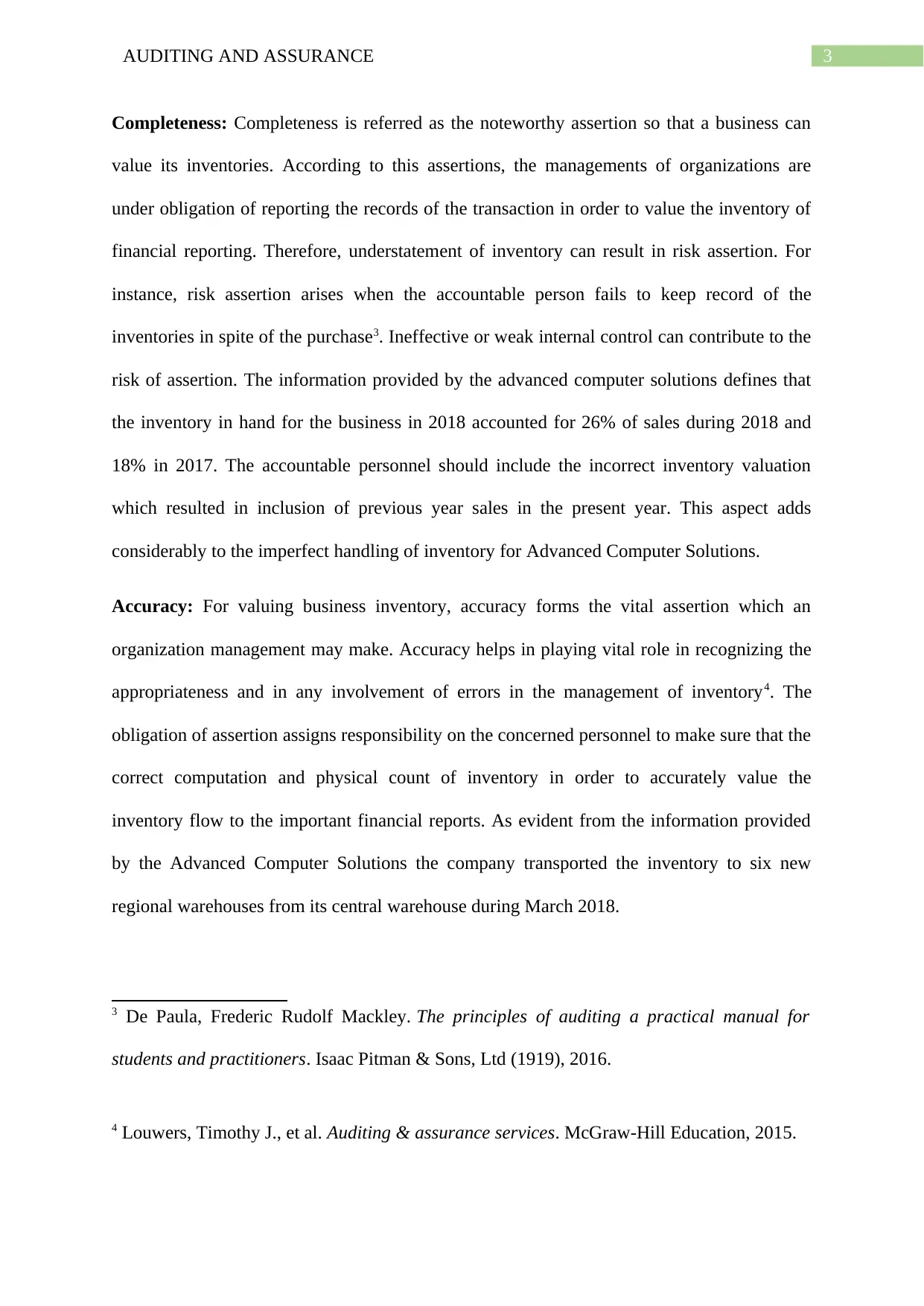
3AUDITING AND ASSURANCE
Completeness: Completeness is referred as the noteworthy assertion so that a business can
value its inventories. According to this assertions, the managements of organizations are
under obligation of reporting the records of the transaction in order to value the inventory of
financial reporting. Therefore, understatement of inventory can result in risk assertion. For
instance, risk assertion arises when the accountable person fails to keep record of the
inventories in spite of the purchase3. Ineffective or weak internal control can contribute to the
risk of assertion. The information provided by the advanced computer solutions defines that
the inventory in hand for the business in 2018 accounted for 26% of sales during 2018 and
18% in 2017. The accountable personnel should include the incorrect inventory valuation
which resulted in inclusion of previous year sales in the present year. This aspect adds
considerably to the imperfect handling of inventory for Advanced Computer Solutions.
Accuracy: For valuing business inventory, accuracy forms the vital assertion which an
organization management may make. Accuracy helps in playing vital role in recognizing the
appropriateness and in any involvement of errors in the management of inventory4. The
obligation of assertion assigns responsibility on the concerned personnel to make sure that the
correct computation and physical count of inventory in order to accurately value the
inventory flow to the important financial reports. As evident from the information provided
by the Advanced Computer Solutions the company transported the inventory to six new
regional warehouses from its central warehouse during March 2018.
3 De Paula, Frederic Rudolf Mackley. The principles of auditing a practical manual for
students and practitioners. Isaac Pitman & Sons, Ltd (1919), 2016.
4 Louwers, Timothy J., et al. Auditing & assurance services. McGraw-Hill Education, 2015.
Completeness: Completeness is referred as the noteworthy assertion so that a business can
value its inventories. According to this assertions, the managements of organizations are
under obligation of reporting the records of the transaction in order to value the inventory of
financial reporting. Therefore, understatement of inventory can result in risk assertion. For
instance, risk assertion arises when the accountable person fails to keep record of the
inventories in spite of the purchase3. Ineffective or weak internal control can contribute to the
risk of assertion. The information provided by the advanced computer solutions defines that
the inventory in hand for the business in 2018 accounted for 26% of sales during 2018 and
18% in 2017. The accountable personnel should include the incorrect inventory valuation
which resulted in inclusion of previous year sales in the present year. This aspect adds
considerably to the imperfect handling of inventory for Advanced Computer Solutions.
Accuracy: For valuing business inventory, accuracy forms the vital assertion which an
organization management may make. Accuracy helps in playing vital role in recognizing the
appropriateness and in any involvement of errors in the management of inventory4. The
obligation of assertion assigns responsibility on the concerned personnel to make sure that the
correct computation and physical count of inventory in order to accurately value the
inventory flow to the important financial reports. As evident from the information provided
by the Advanced Computer Solutions the company transported the inventory to six new
regional warehouses from its central warehouse during March 2018.
3 De Paula, Frederic Rudolf Mackley. The principles of auditing a practical manual for
students and practitioners. Isaac Pitman & Sons, Ltd (1919), 2016.
4 Louwers, Timothy J., et al. Auditing & assurance services. McGraw-Hill Education, 2015.
Paraphrase This Document
Need a fresh take? Get an instant paraphrase of this document with our AI Paraphraser
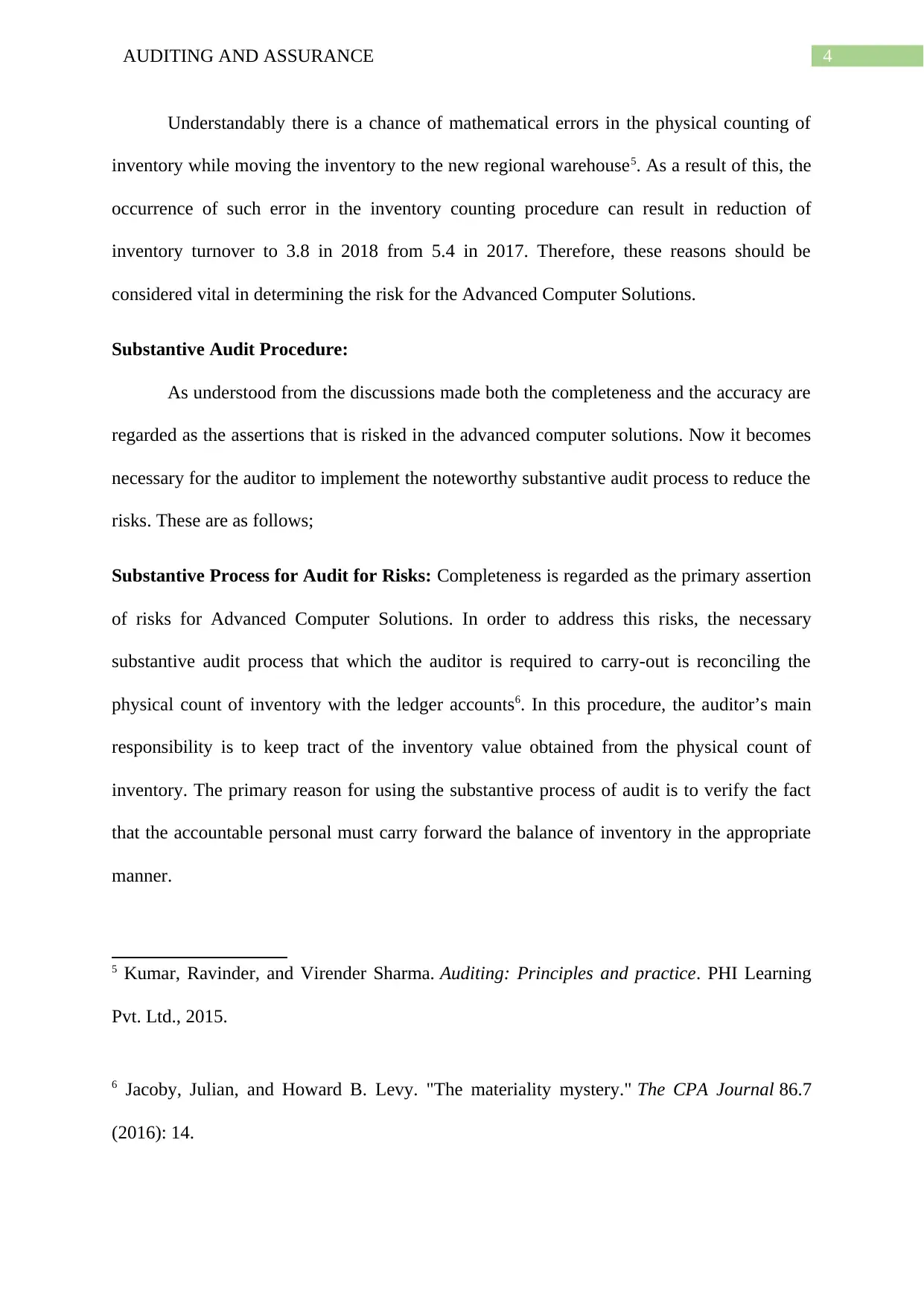
4AUDITING AND ASSURANCE
Understandably there is a chance of mathematical errors in the physical counting of
inventory while moving the inventory to the new regional warehouse5. As a result of this, the
occurrence of such error in the inventory counting procedure can result in reduction of
inventory turnover to 3.8 in 2018 from 5.4 in 2017. Therefore, these reasons should be
considered vital in determining the risk for the Advanced Computer Solutions.
Substantive Audit Procedure:
As understood from the discussions made both the completeness and the accuracy are
regarded as the assertions that is risked in the advanced computer solutions. Now it becomes
necessary for the auditor to implement the noteworthy substantive audit process to reduce the
risks. These are as follows;
Substantive Process for Audit for Risks: Completeness is regarded as the primary assertion
of risks for Advanced Computer Solutions. In order to address this risks, the necessary
substantive audit process that which the auditor is required to carry-out is reconciling the
physical count of inventory with the ledger accounts6. In this procedure, the auditor’s main
responsibility is to keep tract of the inventory value obtained from the physical count of
inventory. The primary reason for using the substantive process of audit is to verify the fact
that the accountable personal must carry forward the balance of inventory in the appropriate
manner.
5 Kumar, Ravinder, and Virender Sharma. Auditing: Principles and practice. PHI Learning
Pvt. Ltd., 2015.
6 Jacoby, Julian, and Howard B. Levy. "The materiality mystery." The CPA Journal 86.7
(2016): 14.
Understandably there is a chance of mathematical errors in the physical counting of
inventory while moving the inventory to the new regional warehouse5. As a result of this, the
occurrence of such error in the inventory counting procedure can result in reduction of
inventory turnover to 3.8 in 2018 from 5.4 in 2017. Therefore, these reasons should be
considered vital in determining the risk for the Advanced Computer Solutions.
Substantive Audit Procedure:
As understood from the discussions made both the completeness and the accuracy are
regarded as the assertions that is risked in the advanced computer solutions. Now it becomes
necessary for the auditor to implement the noteworthy substantive audit process to reduce the
risks. These are as follows;
Substantive Process for Audit for Risks: Completeness is regarded as the primary assertion
of risks for Advanced Computer Solutions. In order to address this risks, the necessary
substantive audit process that which the auditor is required to carry-out is reconciling the
physical count of inventory with the ledger accounts6. In this procedure, the auditor’s main
responsibility is to keep tract of the inventory value obtained from the physical count of
inventory. The primary reason for using the substantive process of audit is to verify the fact
that the accountable personal must carry forward the balance of inventory in the appropriate
manner.
5 Kumar, Ravinder, and Virender Sharma. Auditing: Principles and practice. PHI Learning
Pvt. Ltd., 2015.
6 Jacoby, Julian, and Howard B. Levy. "The materiality mystery." The CPA Journal 86.7
(2016): 14.
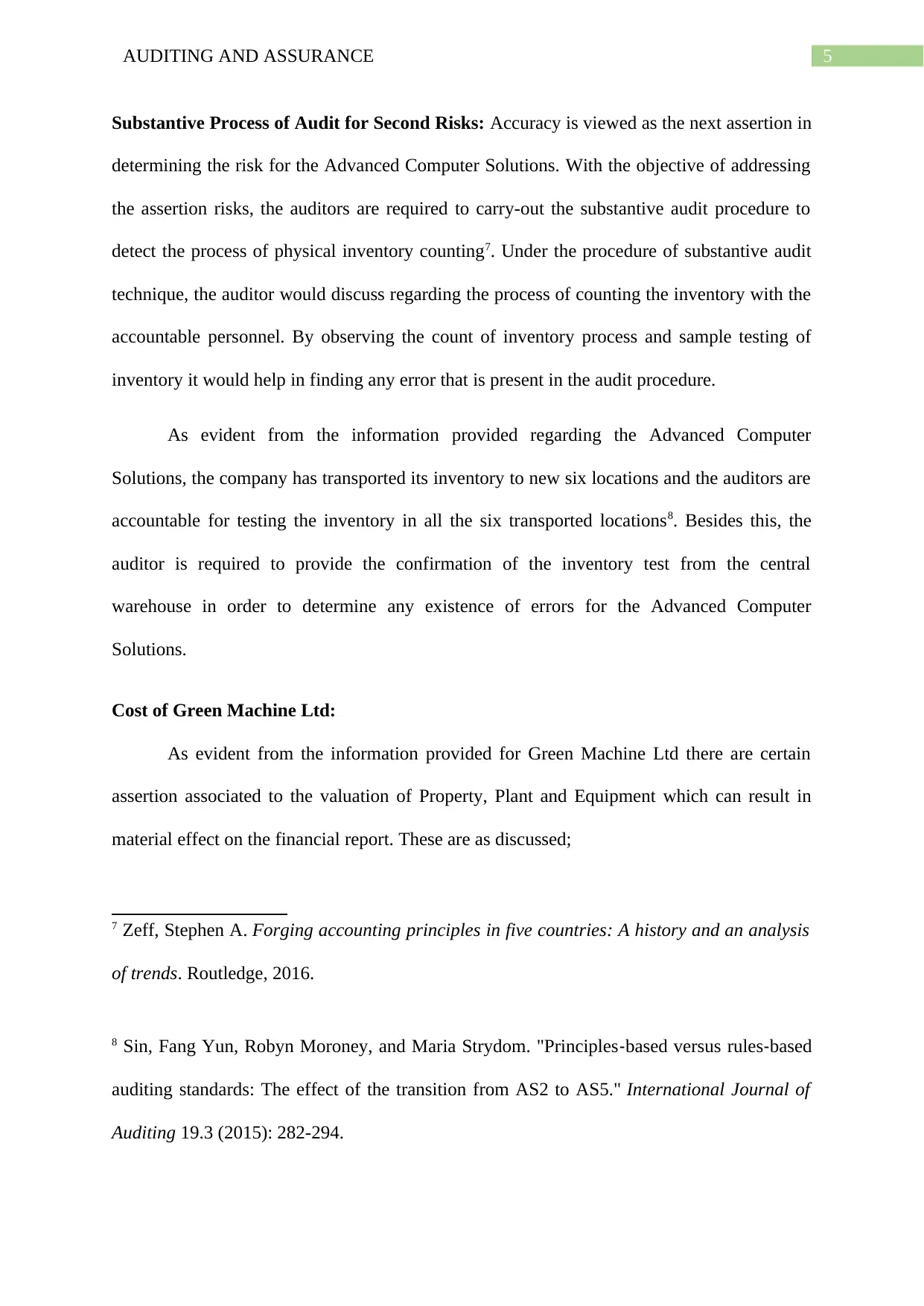
5AUDITING AND ASSURANCE
Substantive Process of Audit for Second Risks: Accuracy is viewed as the next assertion in
determining the risk for the Advanced Computer Solutions. With the objective of addressing
the assertion risks, the auditors are required to carry-out the substantive audit procedure to
detect the process of physical inventory counting7. Under the procedure of substantive audit
technique, the auditor would discuss regarding the process of counting the inventory with the
accountable personnel. By observing the count of inventory process and sample testing of
inventory it would help in finding any error that is present in the audit procedure.
As evident from the information provided regarding the Advanced Computer
Solutions, the company has transported its inventory to new six locations and the auditors are
accountable for testing the inventory in all the six transported locations8. Besides this, the
auditor is required to provide the confirmation of the inventory test from the central
warehouse in order to determine any existence of errors for the Advanced Computer
Solutions.
Cost of Green Machine Ltd:
As evident from the information provided for Green Machine Ltd there are certain
assertion associated to the valuation of Property, Plant and Equipment which can result in
material effect on the financial report. These are as discussed;
7 Zeff, Stephen A. Forging accounting principles in five countries: A history and an analysis
of trends. Routledge, 2016.
8 Sin, Fang Yun, Robyn Moroney, and Maria Strydom. "Principles‐based versus rules‐based
auditing standards: The effect of the transition from AS2 to AS5." International Journal of
Auditing 19.3 (2015): 282-294.
Substantive Process of Audit for Second Risks: Accuracy is viewed as the next assertion in
determining the risk for the Advanced Computer Solutions. With the objective of addressing
the assertion risks, the auditors are required to carry-out the substantive audit procedure to
detect the process of physical inventory counting7. Under the procedure of substantive audit
technique, the auditor would discuss regarding the process of counting the inventory with the
accountable personnel. By observing the count of inventory process and sample testing of
inventory it would help in finding any error that is present in the audit procedure.
As evident from the information provided regarding the Advanced Computer
Solutions, the company has transported its inventory to new six locations and the auditors are
accountable for testing the inventory in all the six transported locations8. Besides this, the
auditor is required to provide the confirmation of the inventory test from the central
warehouse in order to determine any existence of errors for the Advanced Computer
Solutions.
Cost of Green Machine Ltd:
As evident from the information provided for Green Machine Ltd there are certain
assertion associated to the valuation of Property, Plant and Equipment which can result in
material effect on the financial report. These are as discussed;
7 Zeff, Stephen A. Forging accounting principles in five countries: A history and an analysis
of trends. Routledge, 2016.
8 Sin, Fang Yun, Robyn Moroney, and Maria Strydom. "Principles‐based versus rules‐based
auditing standards: The effect of the transition from AS2 to AS5." International Journal of
Auditing 19.3 (2015): 282-294.
⊘ This is a preview!⊘
Do you want full access?
Subscribe today to unlock all pages.

Trusted by 1+ million students worldwide
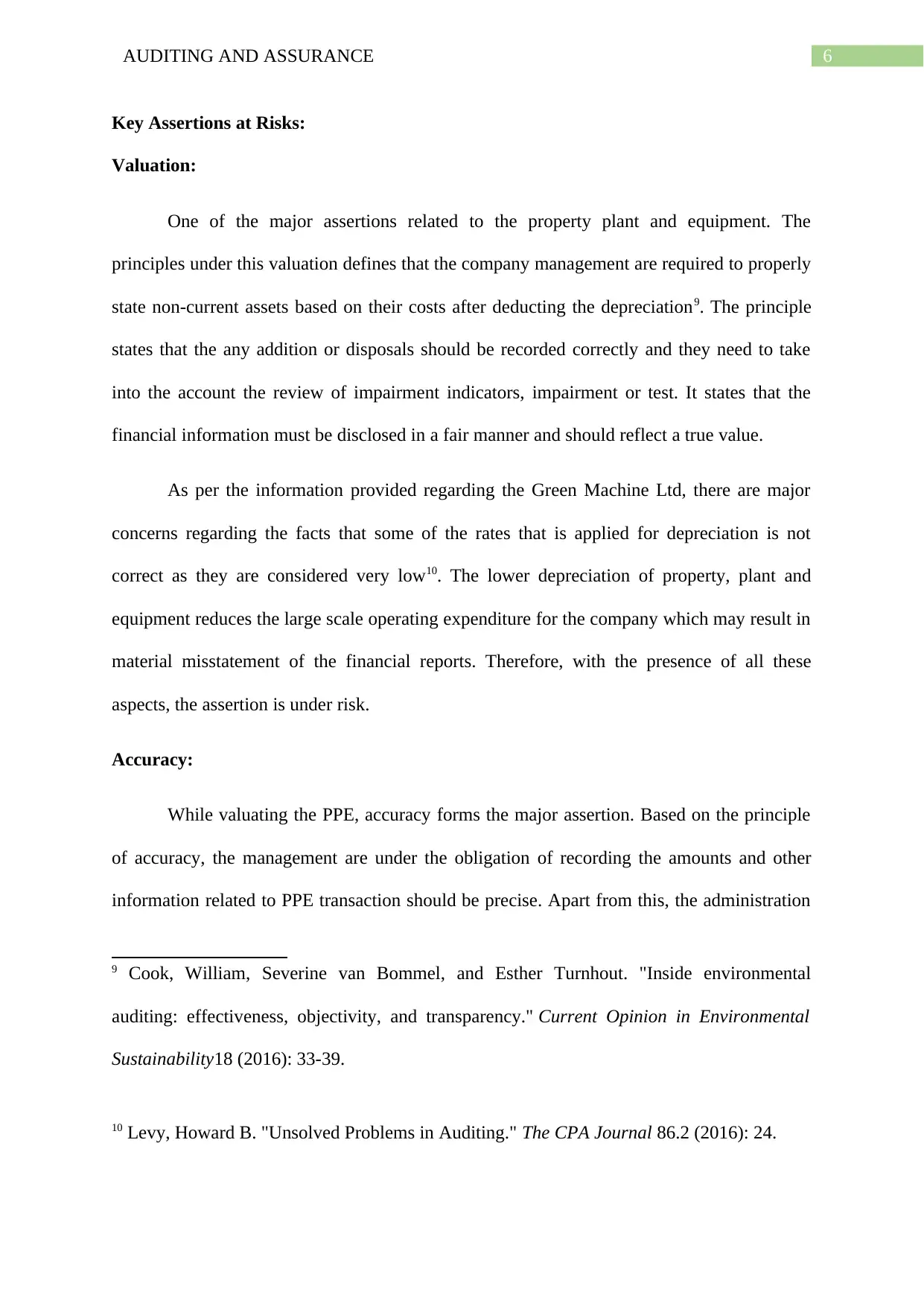
6AUDITING AND ASSURANCE
Key Assertions at Risks:
Valuation:
One of the major assertions related to the property plant and equipment. The
principles under this valuation defines that the company management are required to properly
state non-current assets based on their costs after deducting the depreciation9. The principle
states that the any addition or disposals should be recorded correctly and they need to take
into the account the review of impairment indicators, impairment or test. It states that the
financial information must be disclosed in a fair manner and should reflect a true value.
As per the information provided regarding the Green Machine Ltd, there are major
concerns regarding the facts that some of the rates that is applied for depreciation is not
correct as they are considered very low10. The lower depreciation of property, plant and
equipment reduces the large scale operating expenditure for the company which may result in
material misstatement of the financial reports. Therefore, with the presence of all these
aspects, the assertion is under risk.
Accuracy:
While valuating the PPE, accuracy forms the major assertion. Based on the principle
of accuracy, the management are under the obligation of recording the amounts and other
information related to PPE transaction should be precise. Apart from this, the administration
9 Cook, William, Severine van Bommel, and Esther Turnhout. "Inside environmental
auditing: effectiveness, objectivity, and transparency." Current Opinion in Environmental
Sustainability18 (2016): 33-39.
10 Levy, Howard B. "Unsolved Problems in Auditing." The CPA Journal 86.2 (2016): 24.
Key Assertions at Risks:
Valuation:
One of the major assertions related to the property plant and equipment. The
principles under this valuation defines that the company management are required to properly
state non-current assets based on their costs after deducting the depreciation9. The principle
states that the any addition or disposals should be recorded correctly and they need to take
into the account the review of impairment indicators, impairment or test. It states that the
financial information must be disclosed in a fair manner and should reflect a true value.
As per the information provided regarding the Green Machine Ltd, there are major
concerns regarding the facts that some of the rates that is applied for depreciation is not
correct as they are considered very low10. The lower depreciation of property, plant and
equipment reduces the large scale operating expenditure for the company which may result in
material misstatement of the financial reports. Therefore, with the presence of all these
aspects, the assertion is under risk.
Accuracy:
While valuating the PPE, accuracy forms the major assertion. Based on the principle
of accuracy, the management are under the obligation of recording the amounts and other
information related to PPE transaction should be precise. Apart from this, the administration
9 Cook, William, Severine van Bommel, and Esther Turnhout. "Inside environmental
auditing: effectiveness, objectivity, and transparency." Current Opinion in Environmental
Sustainability18 (2016): 33-39.
10 Levy, Howard B. "Unsolved Problems in Auditing." The CPA Journal 86.2 (2016): 24.
Paraphrase This Document
Need a fresh take? Get an instant paraphrase of this document with our AI Paraphraser

7AUDITING AND ASSURANCE
of the companies must make appropriate distinguish among the capital and revenue
expenses11. As understood from the information provided by the Green Machine Ltd the
management has made an error in distinguishing between the capital and revenue expenses.
They management have capitalized definite items that should be treated as revenue
expenditure and they have also included certain items of capital nature under repair and
maintenance in the income statement. As a result of this, this assertion of Green Machine Ltd
is under risks.
Substantive Audit Procedure:
Following the recognition of audit assertion risks, the auditors are required to
implement the necessary substantive audit process to reduce the risk. The certain risks
minimization process is stated below;
Substantive Audit Process for First Risk: As evident from the above stated discussion that
the management of the Green Machine Ltd has implemented the low rate of depreciation on
the property plant and equipment. Therefore, as the substantive process, the auditor is under
obligation of considering the depreciation rates in relation to the lifetime of the property,
plant and equipment such as the residual amount of the assets, profit or losses on the disposal,
consistency of the company with the necessary accounting policies for applying the
depreciation along with the policy of replacement12. Following this, it is necessary for the
11 Gustavson, Maria, and Aksel Sundström. "Organizing the audit society: Does good
auditing generate less public sector corruption?." Administration & Society 50.10 (2018):
1508-1532.
12 Carla, Yohana, and Auditing Accounting. "Audit style and financial statement
comparability." (2017).
of the companies must make appropriate distinguish among the capital and revenue
expenses11. As understood from the information provided by the Green Machine Ltd the
management has made an error in distinguishing between the capital and revenue expenses.
They management have capitalized definite items that should be treated as revenue
expenditure and they have also included certain items of capital nature under repair and
maintenance in the income statement. As a result of this, this assertion of Green Machine Ltd
is under risks.
Substantive Audit Procedure:
Following the recognition of audit assertion risks, the auditors are required to
implement the necessary substantive audit process to reduce the risk. The certain risks
minimization process is stated below;
Substantive Audit Process for First Risk: As evident from the above stated discussion that
the management of the Green Machine Ltd has implemented the low rate of depreciation on
the property plant and equipment. Therefore, as the substantive process, the auditor is under
obligation of considering the depreciation rates in relation to the lifetime of the property,
plant and equipment such as the residual amount of the assets, profit or losses on the disposal,
consistency of the company with the necessary accounting policies for applying the
depreciation along with the policy of replacement12. Following this, it is necessary for the
11 Gustavson, Maria, and Aksel Sundström. "Organizing the audit society: Does good
auditing generate less public sector corruption?." Administration & Society 50.10 (2018):
1508-1532.
12 Carla, Yohana, and Auditing Accounting. "Audit style and financial statement
comparability." (2017).
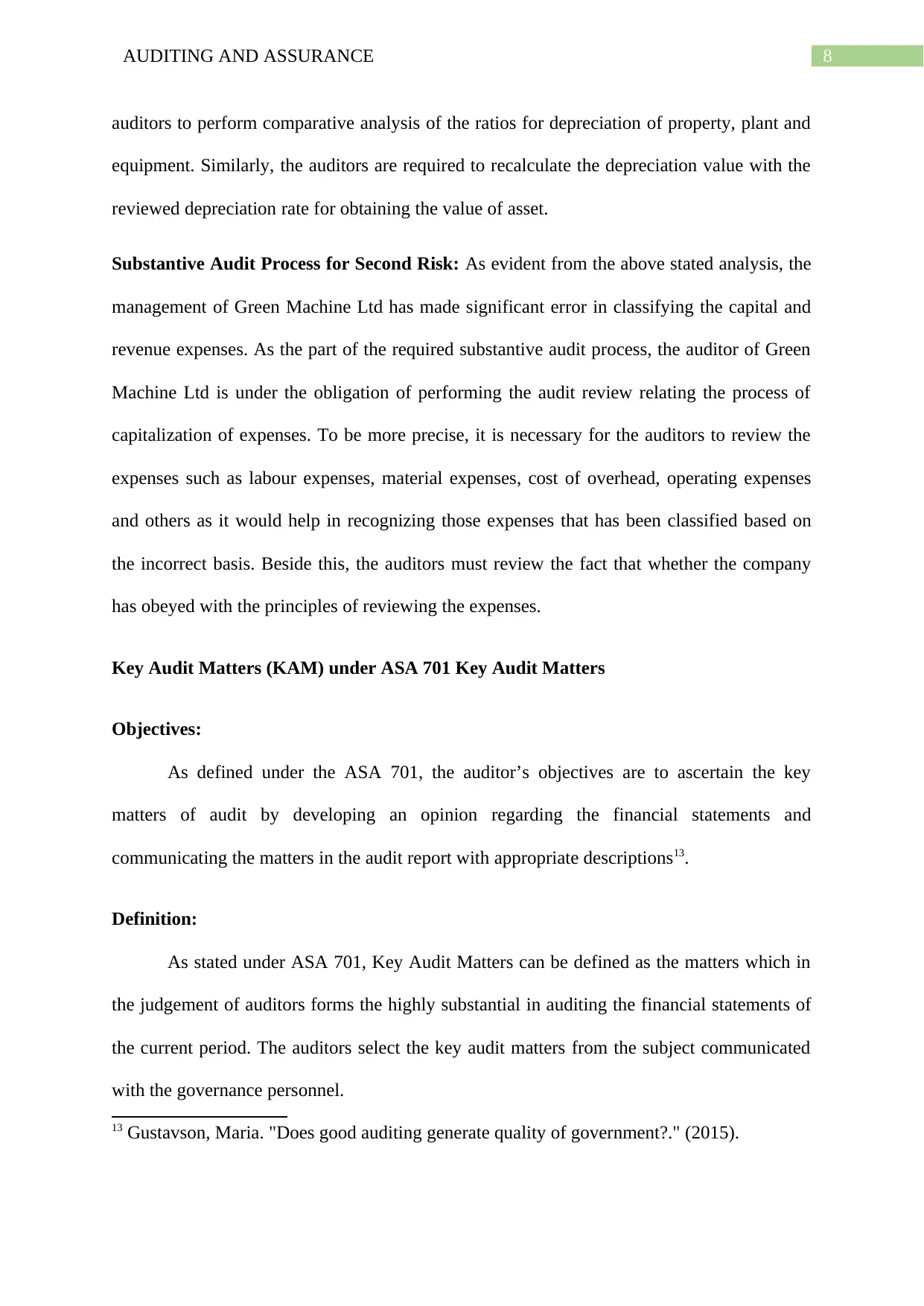
8AUDITING AND ASSURANCE
auditors to perform comparative analysis of the ratios for depreciation of property, plant and
equipment. Similarly, the auditors are required to recalculate the depreciation value with the
reviewed depreciation rate for obtaining the value of asset.
Substantive Audit Process for Second Risk: As evident from the above stated analysis, the
management of Green Machine Ltd has made significant error in classifying the capital and
revenue expenses. As the part of the required substantive audit process, the auditor of Green
Machine Ltd is under the obligation of performing the audit review relating the process of
capitalization of expenses. To be more precise, it is necessary for the auditors to review the
expenses such as labour expenses, material expenses, cost of overhead, operating expenses
and others as it would help in recognizing those expenses that has been classified based on
the incorrect basis. Beside this, the auditors must review the fact that whether the company
has obeyed with the principles of reviewing the expenses.
Key Audit Matters (KAM) under ASA 701 Key Audit Matters
Objectives:
As defined under the ASA 701, the auditor’s objectives are to ascertain the key
matters of audit by developing an opinion regarding the financial statements and
communicating the matters in the audit report with appropriate descriptions13.
Definition:
As stated under ASA 701, Key Audit Matters can be defined as the matters which in
the judgement of auditors forms the highly substantial in auditing the financial statements of
the current period. The auditors select the key audit matters from the subject communicated
with the governance personnel.
13 Gustavson, Maria. "Does good auditing generate quality of government?." (2015).
auditors to perform comparative analysis of the ratios for depreciation of property, plant and
equipment. Similarly, the auditors are required to recalculate the depreciation value with the
reviewed depreciation rate for obtaining the value of asset.
Substantive Audit Process for Second Risk: As evident from the above stated analysis, the
management of Green Machine Ltd has made significant error in classifying the capital and
revenue expenses. As the part of the required substantive audit process, the auditor of Green
Machine Ltd is under the obligation of performing the audit review relating the process of
capitalization of expenses. To be more precise, it is necessary for the auditors to review the
expenses such as labour expenses, material expenses, cost of overhead, operating expenses
and others as it would help in recognizing those expenses that has been classified based on
the incorrect basis. Beside this, the auditors must review the fact that whether the company
has obeyed with the principles of reviewing the expenses.
Key Audit Matters (KAM) under ASA 701 Key Audit Matters
Objectives:
As defined under the ASA 701, the auditor’s objectives are to ascertain the key
matters of audit by developing an opinion regarding the financial statements and
communicating the matters in the audit report with appropriate descriptions13.
Definition:
As stated under ASA 701, Key Audit Matters can be defined as the matters which in
the judgement of auditors forms the highly substantial in auditing the financial statements of
the current period. The auditors select the key audit matters from the subject communicated
with the governance personnel.
13 Gustavson, Maria. "Does good auditing generate quality of government?." (2015).
⊘ This is a preview!⊘
Do you want full access?
Subscribe today to unlock all pages.

Trusted by 1+ million students worldwide
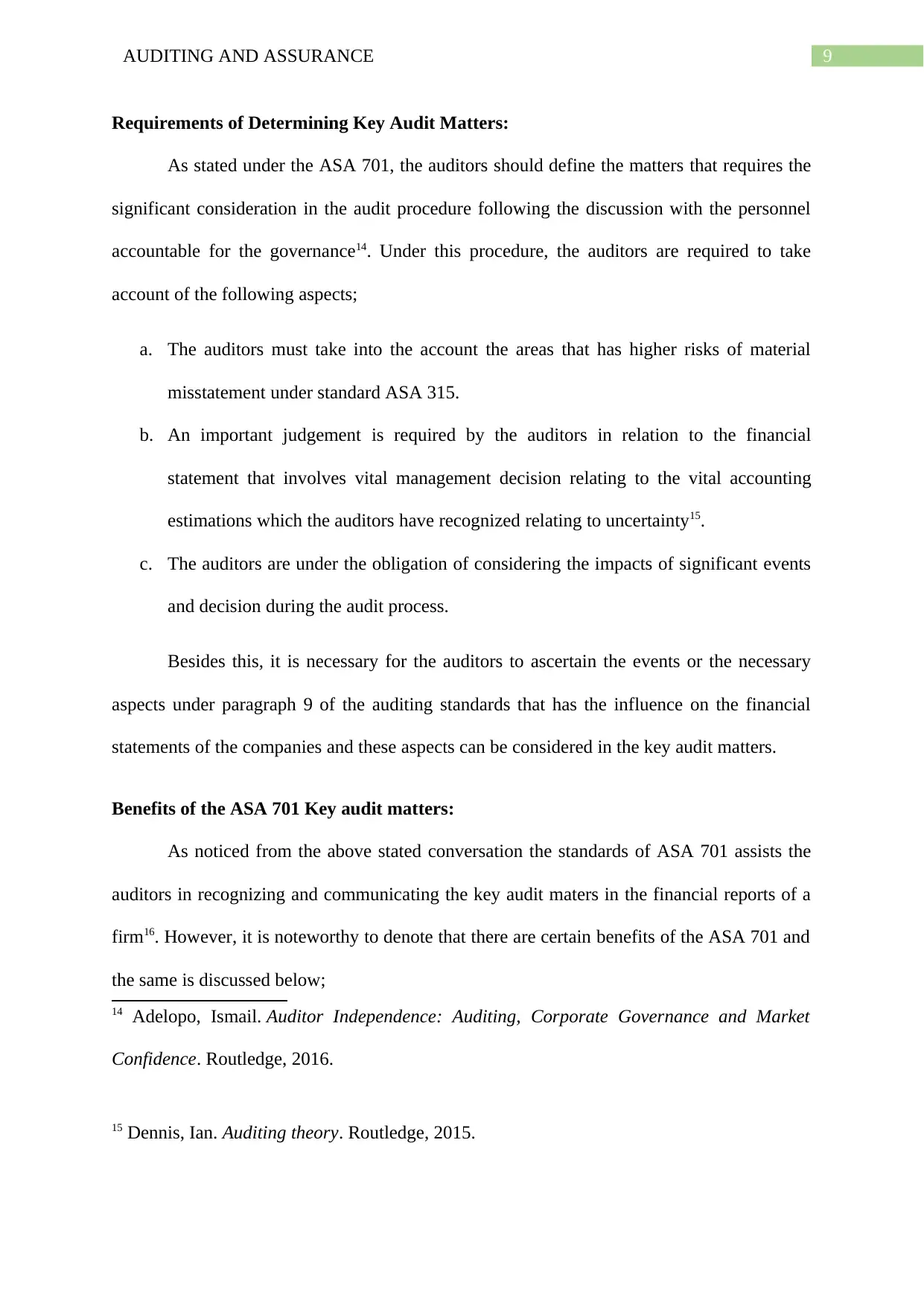
9AUDITING AND ASSURANCE
Requirements of Determining Key Audit Matters:
As stated under the ASA 701, the auditors should define the matters that requires the
significant consideration in the audit procedure following the discussion with the personnel
accountable for the governance14. Under this procedure, the auditors are required to take
account of the following aspects;
a. The auditors must take into the account the areas that has higher risks of material
misstatement under standard ASA 315.
b. An important judgement is required by the auditors in relation to the financial
statement that involves vital management decision relating to the vital accounting
estimations which the auditors have recognized relating to uncertainty15.
c. The auditors are under the obligation of considering the impacts of significant events
and decision during the audit process.
Besides this, it is necessary for the auditors to ascertain the events or the necessary
aspects under paragraph 9 of the auditing standards that has the influence on the financial
statements of the companies and these aspects can be considered in the key audit matters.
Benefits of the ASA 701 Key audit matters:
As noticed from the above stated conversation the standards of ASA 701 assists the
auditors in recognizing and communicating the key audit maters in the financial reports of a
firm16. However, it is noteworthy to denote that there are certain benefits of the ASA 701 and
the same is discussed below;
14 Adelopo, Ismail. Auditor Independence: Auditing, Corporate Governance and Market
Confidence. Routledge, 2016.
15 Dennis, Ian. Auditing theory. Routledge, 2015.
Requirements of Determining Key Audit Matters:
As stated under the ASA 701, the auditors should define the matters that requires the
significant consideration in the audit procedure following the discussion with the personnel
accountable for the governance14. Under this procedure, the auditors are required to take
account of the following aspects;
a. The auditors must take into the account the areas that has higher risks of material
misstatement under standard ASA 315.
b. An important judgement is required by the auditors in relation to the financial
statement that involves vital management decision relating to the vital accounting
estimations which the auditors have recognized relating to uncertainty15.
c. The auditors are under the obligation of considering the impacts of significant events
and decision during the audit process.
Besides this, it is necessary for the auditors to ascertain the events or the necessary
aspects under paragraph 9 of the auditing standards that has the influence on the financial
statements of the companies and these aspects can be considered in the key audit matters.
Benefits of the ASA 701 Key audit matters:
As noticed from the above stated conversation the standards of ASA 701 assists the
auditors in recognizing and communicating the key audit maters in the financial reports of a
firm16. However, it is noteworthy to denote that there are certain benefits of the ASA 701 and
the same is discussed below;
14 Adelopo, Ismail. Auditor Independence: Auditing, Corporate Governance and Market
Confidence. Routledge, 2016.
15 Dennis, Ian. Auditing theory. Routledge, 2015.
Paraphrase This Document
Need a fresh take? Get an instant paraphrase of this document with our AI Paraphraser
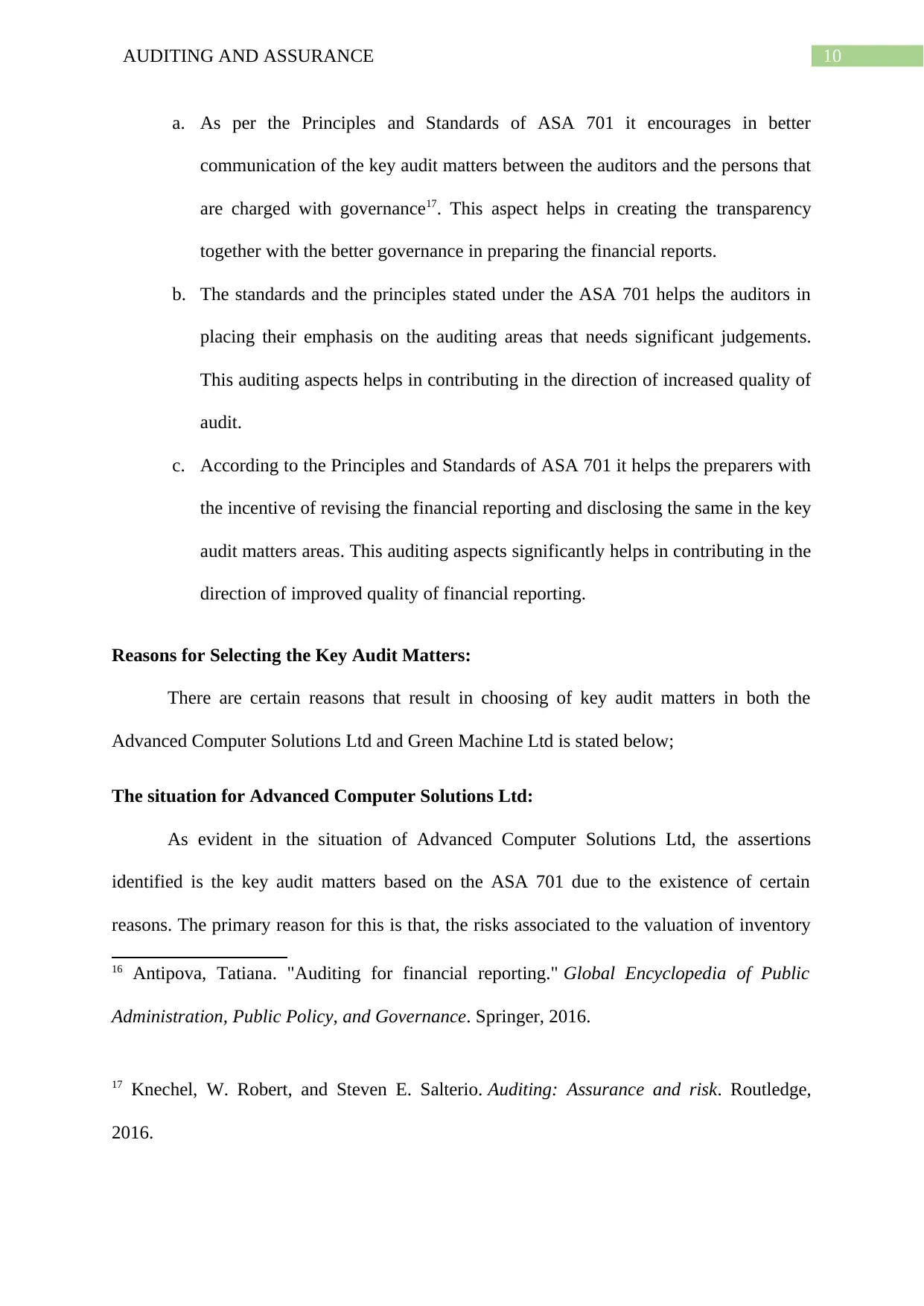
10AUDITING AND ASSURANCE
a. As per the Principles and Standards of ASA 701 it encourages in better
communication of the key audit matters between the auditors and the persons that
are charged with governance17. This aspect helps in creating the transparency
together with the better governance in preparing the financial reports.
b. The standards and the principles stated under the ASA 701 helps the auditors in
placing their emphasis on the auditing areas that needs significant judgements.
This auditing aspects helps in contributing in the direction of increased quality of
audit.
c. According to the Principles and Standards of ASA 701 it helps the preparers with
the incentive of revising the financial reporting and disclosing the same in the key
audit matters areas. This auditing aspects significantly helps in contributing in the
direction of improved quality of financial reporting.
Reasons for Selecting the Key Audit Matters:
There are certain reasons that result in choosing of key audit matters in both the
Advanced Computer Solutions Ltd and Green Machine Ltd is stated below;
The situation for Advanced Computer Solutions Ltd:
As evident in the situation of Advanced Computer Solutions Ltd, the assertions
identified is the key audit matters based on the ASA 701 due to the existence of certain
reasons. The primary reason for this is that, the risks associated to the valuation of inventory
16 Antipova, Tatiana. "Auditing for financial reporting." Global Encyclopedia of Public
Administration, Public Policy, and Governance. Springer, 2016.
17 Knechel, W. Robert, and Steven E. Salterio. Auditing: Assurance and risk. Routledge,
2016.
a. As per the Principles and Standards of ASA 701 it encourages in better
communication of the key audit matters between the auditors and the persons that
are charged with governance17. This aspect helps in creating the transparency
together with the better governance in preparing the financial reports.
b. The standards and the principles stated under the ASA 701 helps the auditors in
placing their emphasis on the auditing areas that needs significant judgements.
This auditing aspects helps in contributing in the direction of increased quality of
audit.
c. According to the Principles and Standards of ASA 701 it helps the preparers with
the incentive of revising the financial reporting and disclosing the same in the key
audit matters areas. This auditing aspects significantly helps in contributing in the
direction of improved quality of financial reporting.
Reasons for Selecting the Key Audit Matters:
There are certain reasons that result in choosing of key audit matters in both the
Advanced Computer Solutions Ltd and Green Machine Ltd is stated below;
The situation for Advanced Computer Solutions Ltd:
As evident in the situation of Advanced Computer Solutions Ltd, the assertions
identified is the key audit matters based on the ASA 701 due to the existence of certain
reasons. The primary reason for this is that, the risks associated to the valuation of inventory
16 Antipova, Tatiana. "Auditing for financial reporting." Global Encyclopedia of Public
Administration, Public Policy, and Governance. Springer, 2016.
17 Knechel, W. Robert, and Steven E. Salterio. Auditing: Assurance and risk. Routledge,
2016.
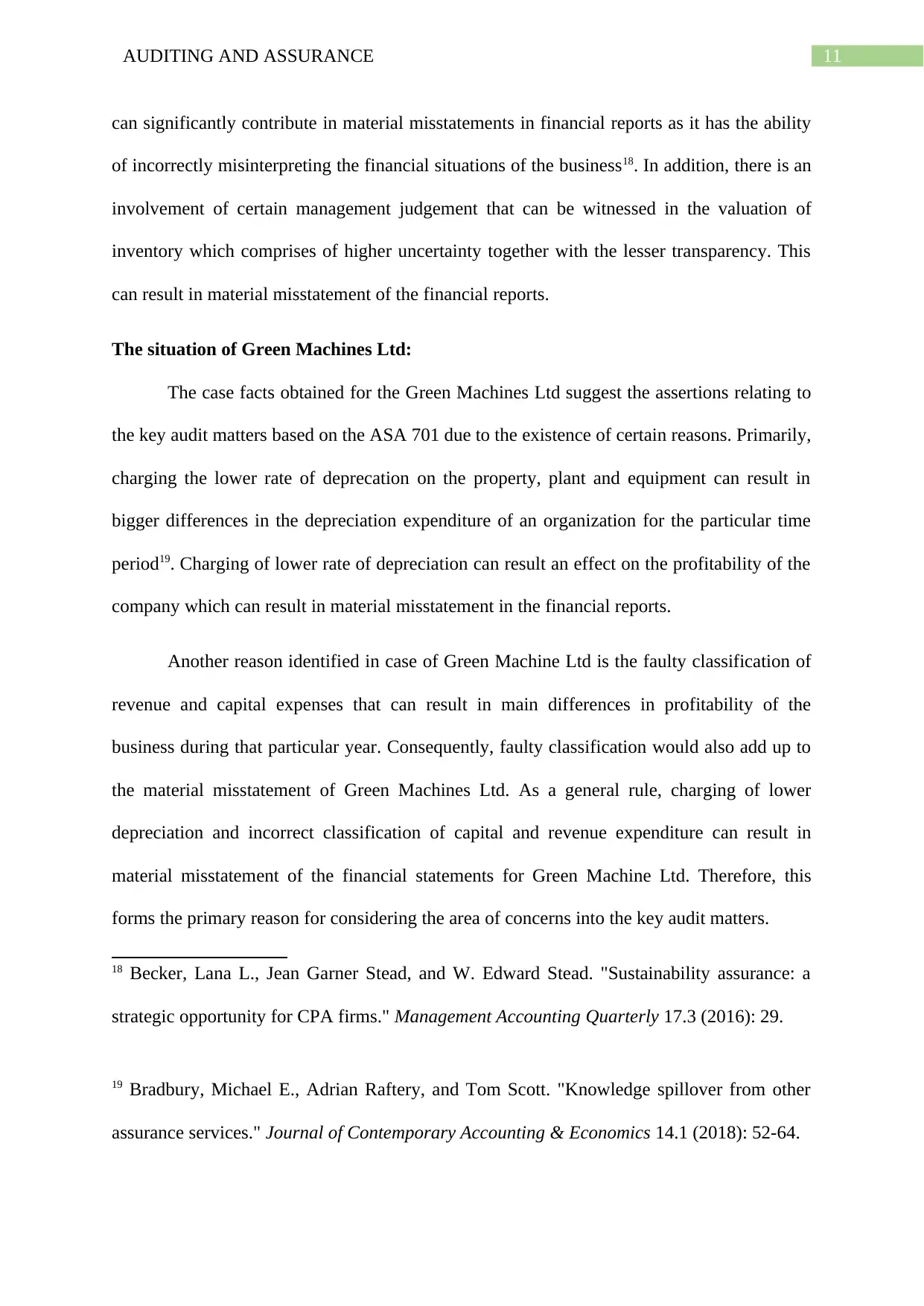
11AUDITING AND ASSURANCE
can significantly contribute in material misstatements in financial reports as it has the ability
of incorrectly misinterpreting the financial situations of the business18. In addition, there is an
involvement of certain management judgement that can be witnessed in the valuation of
inventory which comprises of higher uncertainty together with the lesser transparency. This
can result in material misstatement of the financial reports.
The situation of Green Machines Ltd:
The case facts obtained for the Green Machines Ltd suggest the assertions relating to
the key audit matters based on the ASA 701 due to the existence of certain reasons. Primarily,
charging the lower rate of deprecation on the property, plant and equipment can result in
bigger differences in the depreciation expenditure of an organization for the particular time
period19. Charging of lower rate of depreciation can result an effect on the profitability of the
company which can result in material misstatement in the financial reports.
Another reason identified in case of Green Machine Ltd is the faulty classification of
revenue and capital expenses that can result in main differences in profitability of the
business during that particular year. Consequently, faulty classification would also add up to
the material misstatement of Green Machines Ltd. As a general rule, charging of lower
depreciation and incorrect classification of capital and revenue expenditure can result in
material misstatement of the financial statements for Green Machine Ltd. Therefore, this
forms the primary reason for considering the area of concerns into the key audit matters.
18 Becker, Lana L., Jean Garner Stead, and W. Edward Stead. "Sustainability assurance: a
strategic opportunity for CPA firms." Management Accounting Quarterly 17.3 (2016): 29.
19 Bradbury, Michael E., Adrian Raftery, and Tom Scott. "Knowledge spillover from other
assurance services." Journal of Contemporary Accounting & Economics 14.1 (2018): 52-64.
can significantly contribute in material misstatements in financial reports as it has the ability
of incorrectly misinterpreting the financial situations of the business18. In addition, there is an
involvement of certain management judgement that can be witnessed in the valuation of
inventory which comprises of higher uncertainty together with the lesser transparency. This
can result in material misstatement of the financial reports.
The situation of Green Machines Ltd:
The case facts obtained for the Green Machines Ltd suggest the assertions relating to
the key audit matters based on the ASA 701 due to the existence of certain reasons. Primarily,
charging the lower rate of deprecation on the property, plant and equipment can result in
bigger differences in the depreciation expenditure of an organization for the particular time
period19. Charging of lower rate of depreciation can result an effect on the profitability of the
company which can result in material misstatement in the financial reports.
Another reason identified in case of Green Machine Ltd is the faulty classification of
revenue and capital expenses that can result in main differences in profitability of the
business during that particular year. Consequently, faulty classification would also add up to
the material misstatement of Green Machines Ltd. As a general rule, charging of lower
depreciation and incorrect classification of capital and revenue expenditure can result in
material misstatement of the financial statements for Green Machine Ltd. Therefore, this
forms the primary reason for considering the area of concerns into the key audit matters.
18 Becker, Lana L., Jean Garner Stead, and W. Edward Stead. "Sustainability assurance: a
strategic opportunity for CPA firms." Management Accounting Quarterly 17.3 (2016): 29.
19 Bradbury, Michael E., Adrian Raftery, and Tom Scott. "Knowledge spillover from other
assurance services." Journal of Contemporary Accounting & Economics 14.1 (2018): 52-64.
⊘ This is a preview!⊘
Do you want full access?
Subscribe today to unlock all pages.

Trusted by 1+ million students worldwide
1 out of 15
Related Documents
Your All-in-One AI-Powered Toolkit for Academic Success.
+13062052269
info@desklib.com
Available 24*7 on WhatsApp / Email
![[object Object]](/_next/static/media/star-bottom.7253800d.svg)
Unlock your academic potential
Copyright © 2020–2025 A2Z Services. All Rights Reserved. Developed and managed by ZUCOL.





